BUS293 Report: Commonwealth Bank Culture, Sustainability and Growth
VerifiedAdded on 2023/01/20
|10
|2351
|68
Report
AI Summary
This report provides a detailed analysis of the organizational culture within Commonwealth Bank of Australia, examining its influence on corporate sustainability. The report begins with an executive summary and introduction, setting the stage for a discussion on the importance of a positive organizational culture in fostering employee satisfaction, ethical decision-making, and innovation. It explores how employee empowerment and engagement contribute to a competitive advantage and highlights the role of corporate social responsibility (CSR) in achieving sustainable goals. The report then delves into the specific organizational culture of Commonwealth Bank, emphasizing its supportive environment, commitment to employee growth, and promotion of cultural diversity. It analyzes how these factors contribute to employee retention and engagement, ultimately leading to organizational sustainability. The paper concludes with recommendations for strengthening leadership, promoting internal change makers, fostering open communication, and integrating sustainability into daily business practices, emphasizing the importance of a positive work culture in driving business growth and achieving long-term sustainability goals. The report references various academic sources to support its findings.

Running head: COMMONWEALTH BANK CULTURE
COMMONWEALTH BANK CULTURE
Name of the Student:
Name of the University:
Author Note:
COMMONWEALTH BANK CULTURE
Name of the Student:
Name of the University:
Author Note:
Paraphrase This Document
Need a fresh take? Get an instant paraphrase of this document with our AI Paraphraser
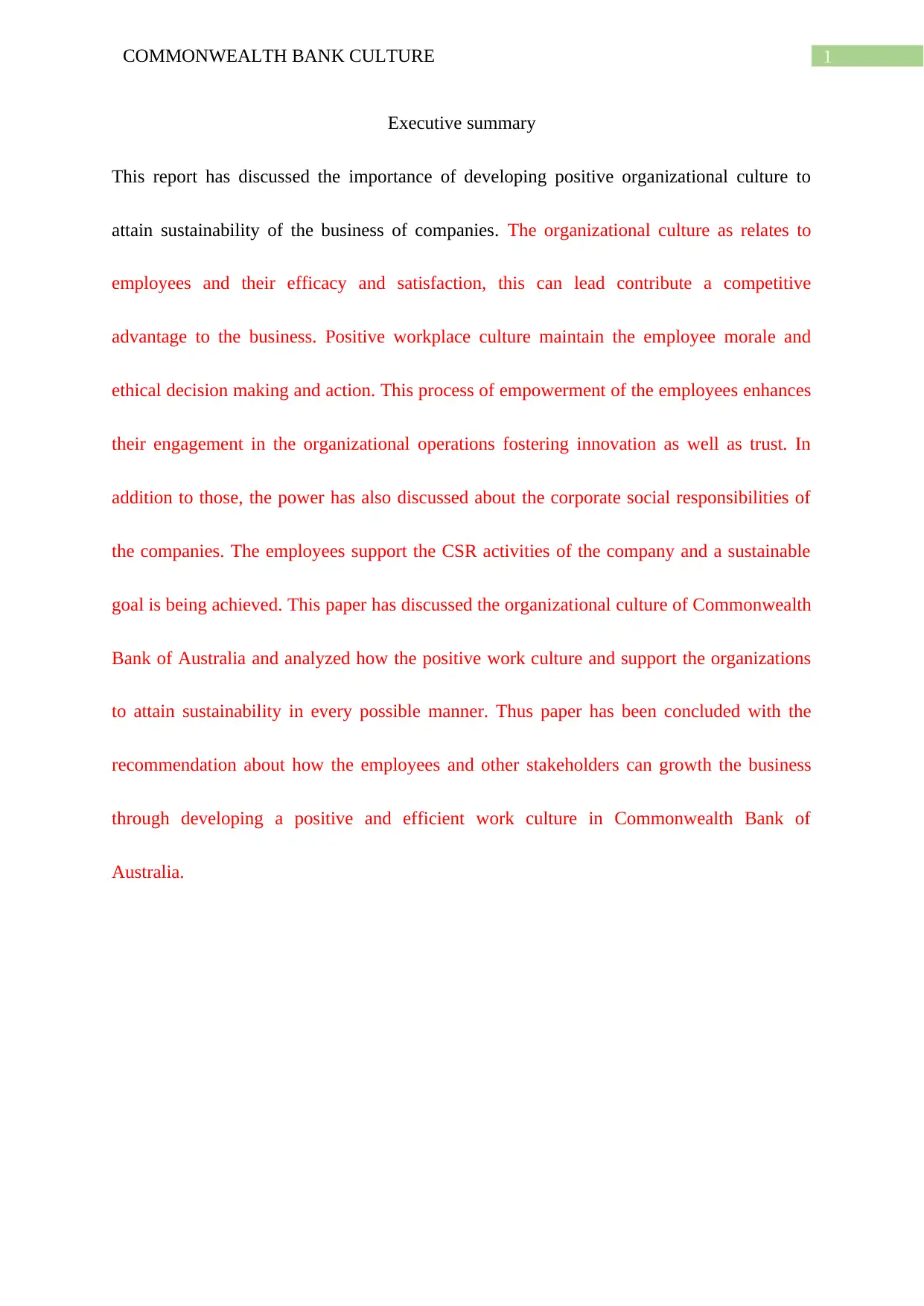
1COMMONWEALTH BANK CULTURE
Executive summary
This report has discussed the importance of developing positive organizational culture to
attain sustainability of the business of companies. The organizational culture as relates to
employees and their efficacy and satisfaction, this can lead contribute a competitive
advantage to the business. Positive workplace culture maintain the employee morale and
ethical decision making and action. This process of empowerment of the employees enhances
their engagement in the organizational operations fostering innovation as well as trust. In
addition to those, the power has also discussed about the corporate social responsibilities of
the companies. The employees support the CSR activities of the company and a sustainable
goal is being achieved. This paper has discussed the organizational culture of Commonwealth
Bank of Australia and analyzed how the positive work culture and support the organizations
to attain sustainability in every possible manner. Thus paper has been concluded with the
recommendation about how the employees and other stakeholders can growth the business
through developing a positive and efficient work culture in Commonwealth Bank of
Australia.
Executive summary
This report has discussed the importance of developing positive organizational culture to
attain sustainability of the business of companies. The organizational culture as relates to
employees and their efficacy and satisfaction, this can lead contribute a competitive
advantage to the business. Positive workplace culture maintain the employee morale and
ethical decision making and action. This process of empowerment of the employees enhances
their engagement in the organizational operations fostering innovation as well as trust. In
addition to those, the power has also discussed about the corporate social responsibilities of
the companies. The employees support the CSR activities of the company and a sustainable
goal is being achieved. This paper has discussed the organizational culture of Commonwealth
Bank of Australia and analyzed how the positive work culture and support the organizations
to attain sustainability in every possible manner. Thus paper has been concluded with the
recommendation about how the employees and other stakeholders can growth the business
through developing a positive and efficient work culture in Commonwealth Bank of
Australia.

2COMMONWEALTH BANK CULTURE
Table of Contents
Introduction:...............................................................................................................................3
Discussion:.................................................................................................................................3
Organisational culture of commonwealth bank of Australia:....................................................6
Recommendation:......................................................................................................................7
Conclusion:................................................................................................................................7
References:.................................................................................................................................8
Table of Contents
Introduction:...............................................................................................................................3
Discussion:.................................................................................................................................3
Organisational culture of commonwealth bank of Australia:....................................................6
Recommendation:......................................................................................................................7
Conclusion:................................................................................................................................7
References:.................................................................................................................................8
⊘ This is a preview!⊘
Do you want full access?
Subscribe today to unlock all pages.

Trusted by 1+ million students worldwide
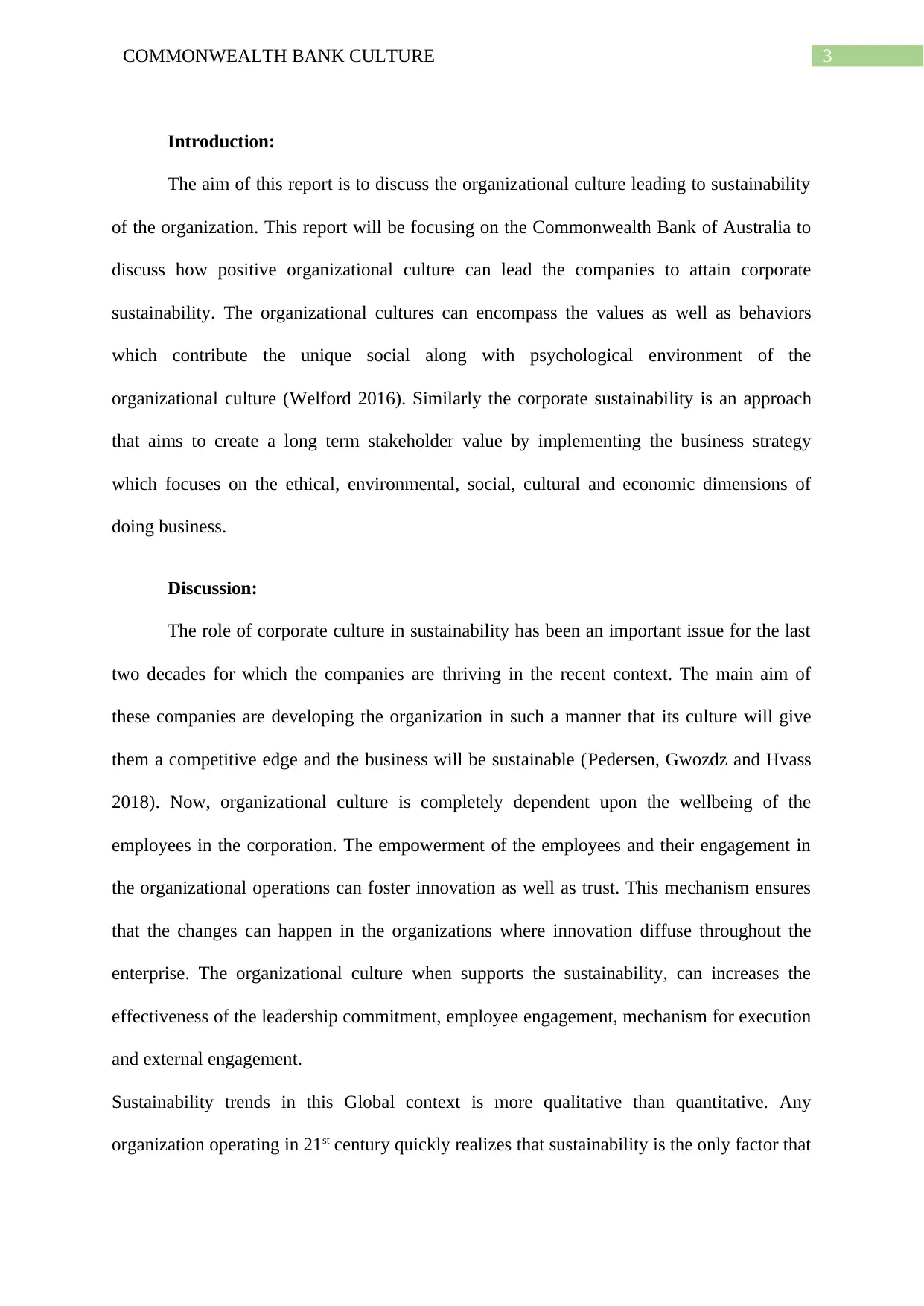
3COMMONWEALTH BANK CULTURE
Introduction:
The aim of this report is to discuss the organizational culture leading to sustainability
of the organization. This report will be focusing on the Commonwealth Bank of Australia to
discuss how positive organizational culture can lead the companies to attain corporate
sustainability. The organizational cultures can encompass the values as well as behaviors
which contribute the unique social along with psychological environment of the
organizational culture (Welford 2016). Similarly the corporate sustainability is an approach
that aims to create a long term stakeholder value by implementing the business strategy
which focuses on the ethical, environmental, social, cultural and economic dimensions of
doing business.
Discussion:
The role of corporate culture in sustainability has been an important issue for the last
two decades for which the companies are thriving in the recent context. The main aim of
these companies are developing the organization in such a manner that its culture will give
them a competitive edge and the business will be sustainable (Pedersen, Gwozdz and Hvass
2018). Now, organizational culture is completely dependent upon the wellbeing of the
employees in the corporation. The empowerment of the employees and their engagement in
the organizational operations can foster innovation as well as trust. This mechanism ensures
that the changes can happen in the organizations where innovation diffuse throughout the
enterprise. The organizational culture when supports the sustainability, can increases the
effectiveness of the leadership commitment, employee engagement, mechanism for execution
and external engagement.
Sustainability trends in this Global context is more qualitative than quantitative. Any
organization operating in 21st century quickly realizes that sustainability is the only factor that
Introduction:
The aim of this report is to discuss the organizational culture leading to sustainability
of the organization. This report will be focusing on the Commonwealth Bank of Australia to
discuss how positive organizational culture can lead the companies to attain corporate
sustainability. The organizational cultures can encompass the values as well as behaviors
which contribute the unique social along with psychological environment of the
organizational culture (Welford 2016). Similarly the corporate sustainability is an approach
that aims to create a long term stakeholder value by implementing the business strategy
which focuses on the ethical, environmental, social, cultural and economic dimensions of
doing business.
Discussion:
The role of corporate culture in sustainability has been an important issue for the last
two decades for which the companies are thriving in the recent context. The main aim of
these companies are developing the organization in such a manner that its culture will give
them a competitive edge and the business will be sustainable (Pedersen, Gwozdz and Hvass
2018). Now, organizational culture is completely dependent upon the wellbeing of the
employees in the corporation. The empowerment of the employees and their engagement in
the organizational operations can foster innovation as well as trust. This mechanism ensures
that the changes can happen in the organizations where innovation diffuse throughout the
enterprise. The organizational culture when supports the sustainability, can increases the
effectiveness of the leadership commitment, employee engagement, mechanism for execution
and external engagement.
Sustainability trends in this Global context is more qualitative than quantitative. Any
organization operating in 21st century quickly realizes that sustainability is the only factor that
Paraphrase This Document
Need a fresh take? Get an instant paraphrase of this document with our AI Paraphraser
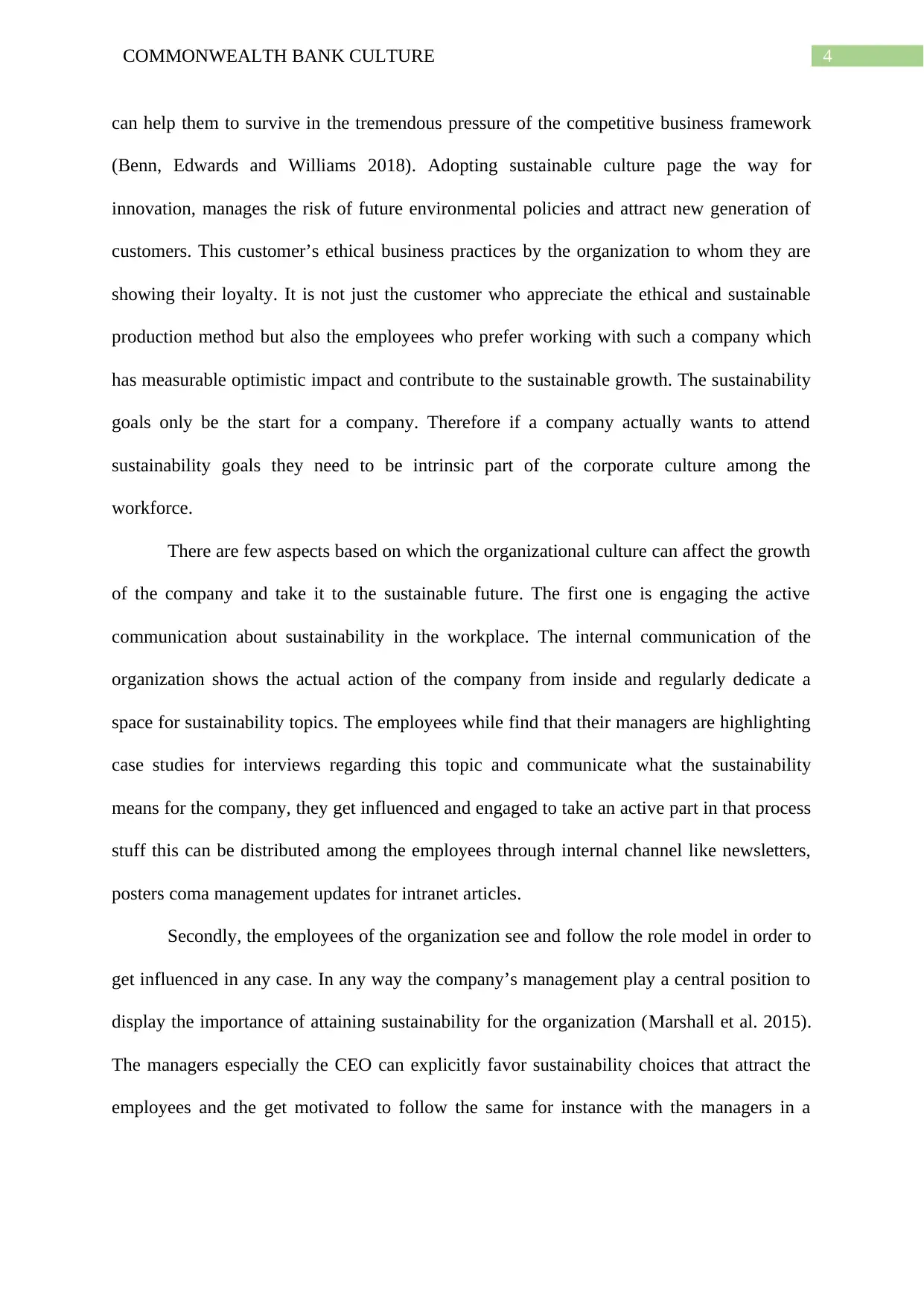
4COMMONWEALTH BANK CULTURE
can help them to survive in the tremendous pressure of the competitive business framework
(Benn, Edwards and Williams 2018). Adopting sustainable culture page the way for
innovation, manages the risk of future environmental policies and attract new generation of
customers. This customer’s ethical business practices by the organization to whom they are
showing their loyalty. It is not just the customer who appreciate the ethical and sustainable
production method but also the employees who prefer working with such a company which
has measurable optimistic impact and contribute to the sustainable growth. The sustainability
goals only be the start for a company. Therefore if a company actually wants to attend
sustainability goals they need to be intrinsic part of the corporate culture among the
workforce.
There are few aspects based on which the organizational culture can affect the growth
of the company and take it to the sustainable future. The first one is engaging the active
communication about sustainability in the workplace. The internal communication of the
organization shows the actual action of the company from inside and regularly dedicate a
space for sustainability topics. The employees while find that their managers are highlighting
case studies for interviews regarding this topic and communicate what the sustainability
means for the company, they get influenced and engaged to take an active part in that process
stuff this can be distributed among the employees through internal channel like newsletters,
posters coma management updates for intranet articles.
Secondly, the employees of the organization see and follow the role model in order to
get influenced in any case. In any way the company’s management play a central position to
display the importance of attaining sustainability for the organization (Marshall et al. 2015).
The managers especially the CEO can explicitly favor sustainability choices that attract the
employees and the get motivated to follow the same for instance with the managers in a
can help them to survive in the tremendous pressure of the competitive business framework
(Benn, Edwards and Williams 2018). Adopting sustainable culture page the way for
innovation, manages the risk of future environmental policies and attract new generation of
customers. This customer’s ethical business practices by the organization to whom they are
showing their loyalty. It is not just the customer who appreciate the ethical and sustainable
production method but also the employees who prefer working with such a company which
has measurable optimistic impact and contribute to the sustainable growth. The sustainability
goals only be the start for a company. Therefore if a company actually wants to attend
sustainability goals they need to be intrinsic part of the corporate culture among the
workforce.
There are few aspects based on which the organizational culture can affect the growth
of the company and take it to the sustainable future. The first one is engaging the active
communication about sustainability in the workplace. The internal communication of the
organization shows the actual action of the company from inside and regularly dedicate a
space for sustainability topics. The employees while find that their managers are highlighting
case studies for interviews regarding this topic and communicate what the sustainability
means for the company, they get influenced and engaged to take an active part in that process
stuff this can be distributed among the employees through internal channel like newsletters,
posters coma management updates for intranet articles.
Secondly, the employees of the organization see and follow the role model in order to
get influenced in any case. In any way the company’s management play a central position to
display the importance of attaining sustainability for the organization (Marshall et al. 2015).
The managers especially the CEO can explicitly favor sustainability choices that attract the
employees and the get motivated to follow the same for instance with the managers in a
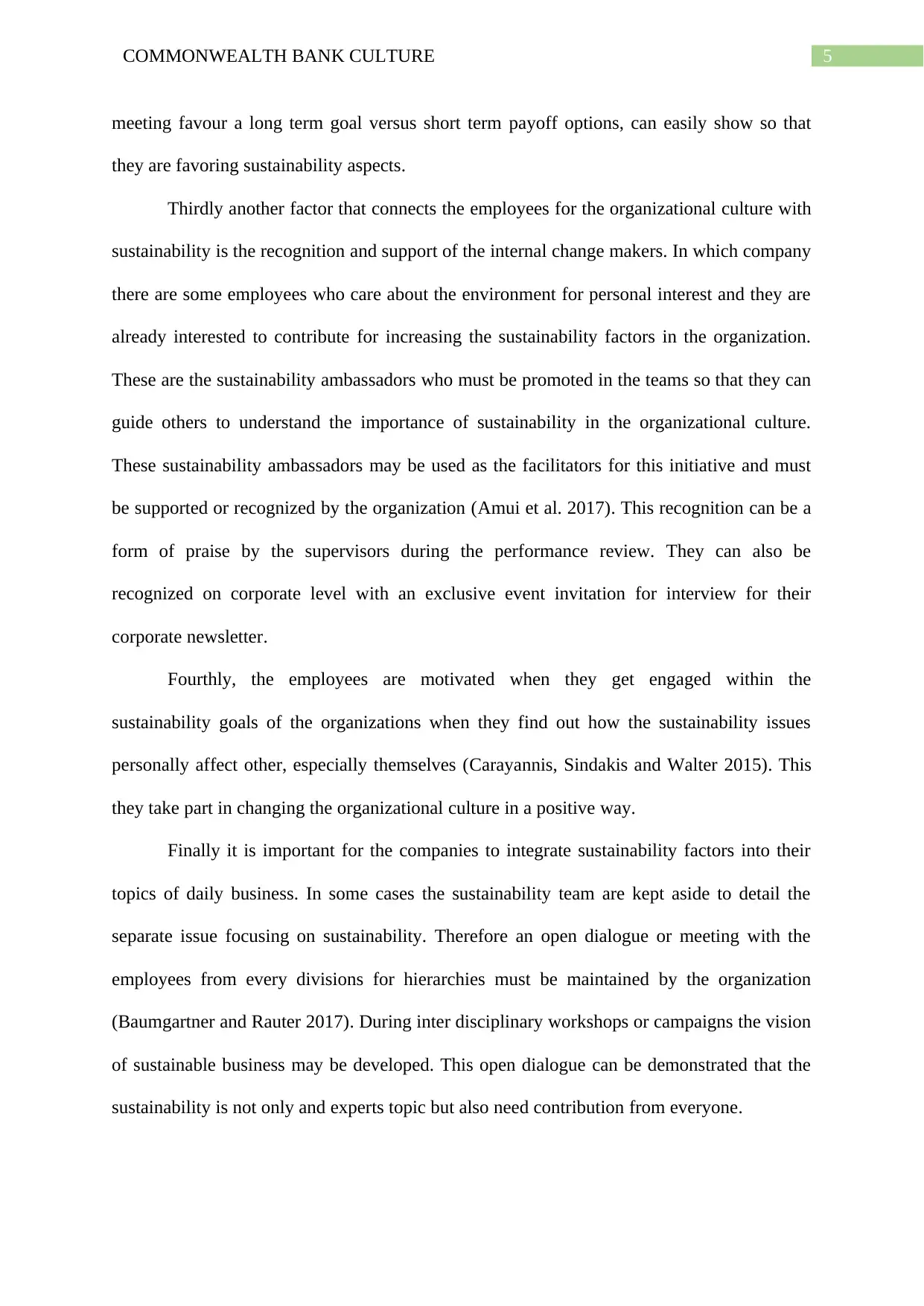
5COMMONWEALTH BANK CULTURE
meeting favour a long term goal versus short term payoff options, can easily show so that
they are favoring sustainability aspects.
Thirdly another factor that connects the employees for the organizational culture with
sustainability is the recognition and support of the internal change makers. In which company
there are some employees who care about the environment for personal interest and they are
already interested to contribute for increasing the sustainability factors in the organization.
These are the sustainability ambassadors who must be promoted in the teams so that they can
guide others to understand the importance of sustainability in the organizational culture.
These sustainability ambassadors may be used as the facilitators for this initiative and must
be supported or recognized by the organization (Amui et al. 2017). This recognition can be a
form of praise by the supervisors during the performance review. They can also be
recognized on corporate level with an exclusive event invitation for interview for their
corporate newsletter.
Fourthly, the employees are motivated when they get engaged within the
sustainability goals of the organizations when they find out how the sustainability issues
personally affect other, especially themselves (Carayannis, Sindakis and Walter 2015). This
they take part in changing the organizational culture in a positive way.
Finally it is important for the companies to integrate sustainability factors into their
topics of daily business. In some cases the sustainability team are kept aside to detail the
separate issue focusing on sustainability. Therefore an open dialogue or meeting with the
employees from every divisions for hierarchies must be maintained by the organization
(Baumgartner and Rauter 2017). During inter disciplinary workshops or campaigns the vision
of sustainable business may be developed. This open dialogue can be demonstrated that the
sustainability is not only and experts topic but also need contribution from everyone.
meeting favour a long term goal versus short term payoff options, can easily show so that
they are favoring sustainability aspects.
Thirdly another factor that connects the employees for the organizational culture with
sustainability is the recognition and support of the internal change makers. In which company
there are some employees who care about the environment for personal interest and they are
already interested to contribute for increasing the sustainability factors in the organization.
These are the sustainability ambassadors who must be promoted in the teams so that they can
guide others to understand the importance of sustainability in the organizational culture.
These sustainability ambassadors may be used as the facilitators for this initiative and must
be supported or recognized by the organization (Amui et al. 2017). This recognition can be a
form of praise by the supervisors during the performance review. They can also be
recognized on corporate level with an exclusive event invitation for interview for their
corporate newsletter.
Fourthly, the employees are motivated when they get engaged within the
sustainability goals of the organizations when they find out how the sustainability issues
personally affect other, especially themselves (Carayannis, Sindakis and Walter 2015). This
they take part in changing the organizational culture in a positive way.
Finally it is important for the companies to integrate sustainability factors into their
topics of daily business. In some cases the sustainability team are kept aside to detail the
separate issue focusing on sustainability. Therefore an open dialogue or meeting with the
employees from every divisions for hierarchies must be maintained by the organization
(Baumgartner and Rauter 2017). During inter disciplinary workshops or campaigns the vision
of sustainable business may be developed. This open dialogue can be demonstrated that the
sustainability is not only and experts topic but also need contribution from everyone.
⊘ This is a preview!⊘
Do you want full access?
Subscribe today to unlock all pages.

Trusted by 1+ million students worldwide
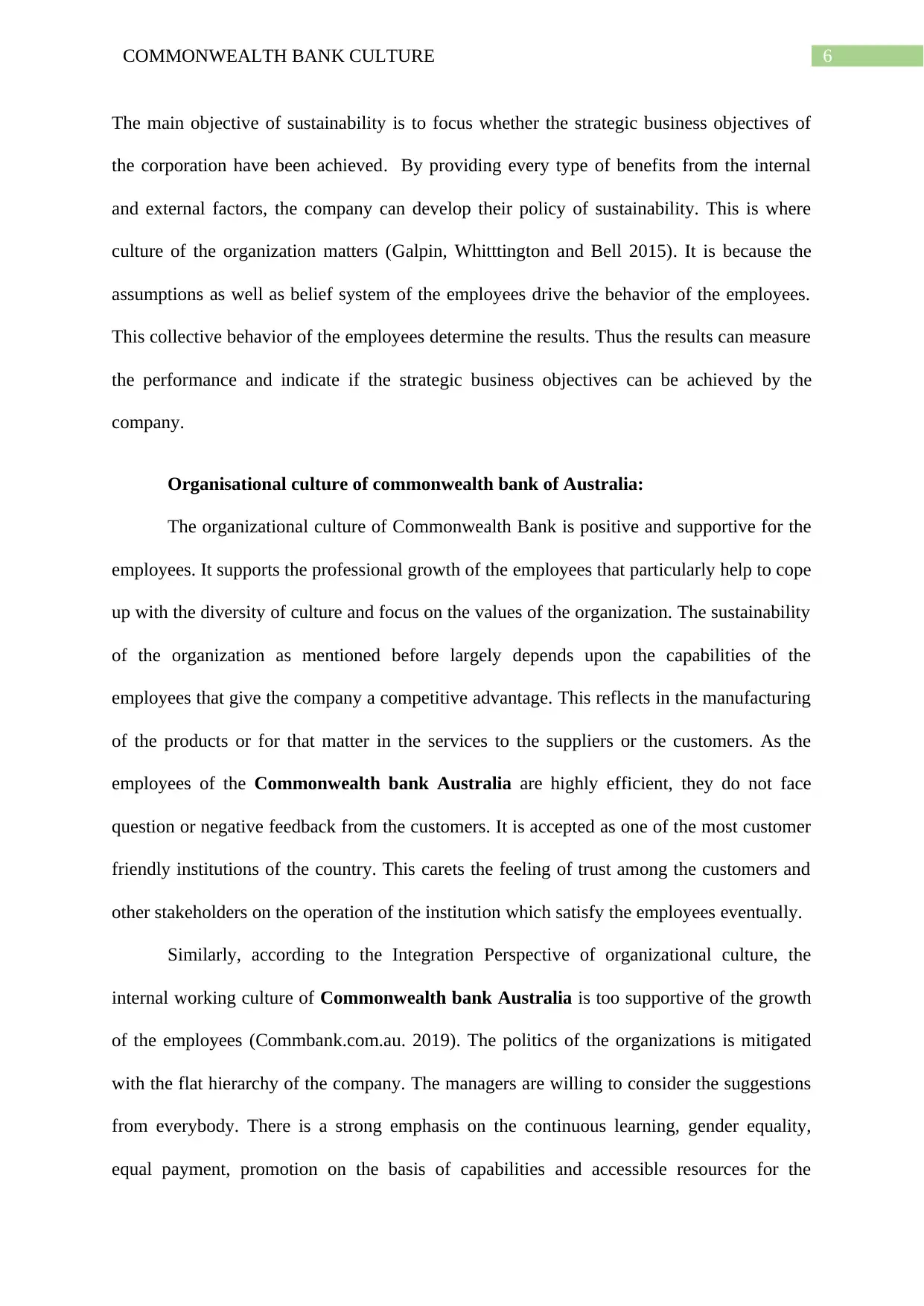
6COMMONWEALTH BANK CULTURE
The main objective of sustainability is to focus whether the strategic business objectives of
the corporation have been achieved. By providing every type of benefits from the internal
and external factors, the company can develop their policy of sustainability. This is where
culture of the organization matters (Galpin, Whitttington and Bell 2015). It is because the
assumptions as well as belief system of the employees drive the behavior of the employees.
This collective behavior of the employees determine the results. Thus the results can measure
the performance and indicate if the strategic business objectives can be achieved by the
company.
Organisational culture of commonwealth bank of Australia:
The organizational culture of Commonwealth Bank is positive and supportive for the
employees. It supports the professional growth of the employees that particularly help to cope
up with the diversity of culture and focus on the values of the organization. The sustainability
of the organization as mentioned before largely depends upon the capabilities of the
employees that give the company a competitive advantage. This reflects in the manufacturing
of the products or for that matter in the services to the suppliers or the customers. As the
employees of the Commonwealth bank Australia are highly efficient, they do not face
question or negative feedback from the customers. It is accepted as one of the most customer
friendly institutions of the country. This carets the feeling of trust among the customers and
other stakeholders on the operation of the institution which satisfy the employees eventually.
Similarly, according to the Integration Perspective of organizational culture, the
internal working culture of Commonwealth bank Australia is too supportive of the growth
of the employees (Commbank.com.au. 2019). The politics of the organizations is mitigated
with the flat hierarchy of the company. The managers are willing to consider the suggestions
from everybody. There is a strong emphasis on the continuous learning, gender equality,
equal payment, promotion on the basis of capabilities and accessible resources for the
The main objective of sustainability is to focus whether the strategic business objectives of
the corporation have been achieved. By providing every type of benefits from the internal
and external factors, the company can develop their policy of sustainability. This is where
culture of the organization matters (Galpin, Whitttington and Bell 2015). It is because the
assumptions as well as belief system of the employees drive the behavior of the employees.
This collective behavior of the employees determine the results. Thus the results can measure
the performance and indicate if the strategic business objectives can be achieved by the
company.
Organisational culture of commonwealth bank of Australia:
The organizational culture of Commonwealth Bank is positive and supportive for the
employees. It supports the professional growth of the employees that particularly help to cope
up with the diversity of culture and focus on the values of the organization. The sustainability
of the organization as mentioned before largely depends upon the capabilities of the
employees that give the company a competitive advantage. This reflects in the manufacturing
of the products or for that matter in the services to the suppliers or the customers. As the
employees of the Commonwealth bank Australia are highly efficient, they do not face
question or negative feedback from the customers. It is accepted as one of the most customer
friendly institutions of the country. This carets the feeling of trust among the customers and
other stakeholders on the operation of the institution which satisfy the employees eventually.
Similarly, according to the Integration Perspective of organizational culture, the
internal working culture of Commonwealth bank Australia is too supportive of the growth
of the employees (Commbank.com.au. 2019). The politics of the organizations is mitigated
with the flat hierarchy of the company. The managers are willing to consider the suggestions
from everybody. There is a strong emphasis on the continuous learning, gender equality,
equal payment, promotion on the basis of capabilities and accessible resources for the
Paraphrase This Document
Need a fresh take? Get an instant paraphrase of this document with our AI Paraphraser
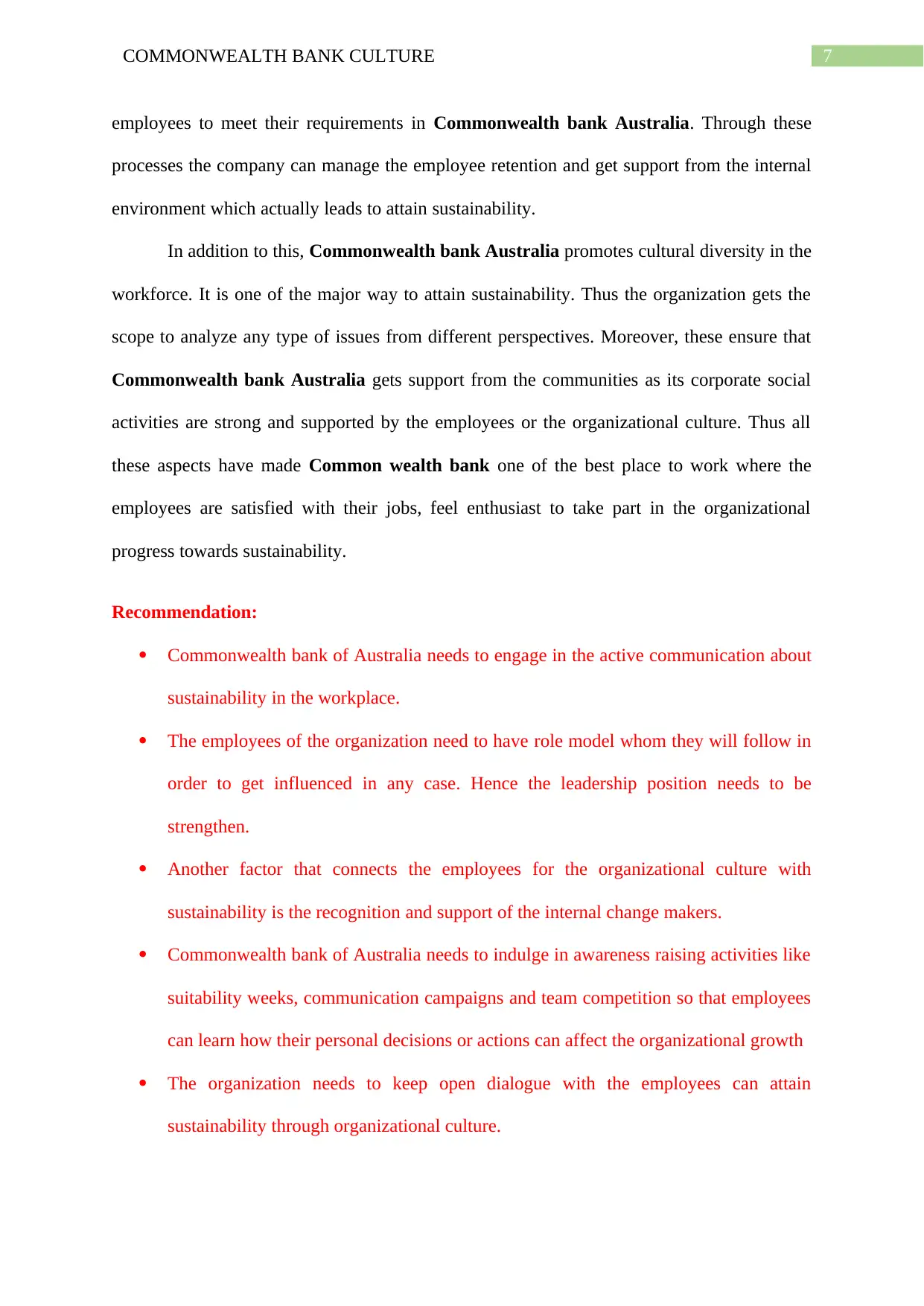
7COMMONWEALTH BANK CULTURE
employees to meet their requirements in Commonwealth bank Australia. Through these
processes the company can manage the employee retention and get support from the internal
environment which actually leads to attain sustainability.
In addition to this, Commonwealth bank Australia promotes cultural diversity in the
workforce. It is one of the major way to attain sustainability. Thus the organization gets the
scope to analyze any type of issues from different perspectives. Moreover, these ensure that
Commonwealth bank Australia gets support from the communities as its corporate social
activities are strong and supported by the employees or the organizational culture. Thus all
these aspects have made Common wealth bank one of the best place to work where the
employees are satisfied with their jobs, feel enthusiast to take part in the organizational
progress towards sustainability.
Recommendation:
Commonwealth bank of Australia needs to engage in the active communication about
sustainability in the workplace.
The employees of the organization need to have role model whom they will follow in
order to get influenced in any case. Hence the leadership position needs to be
strengthen.
Another factor that connects the employees for the organizational culture with
sustainability is the recognition and support of the internal change makers.
Commonwealth bank of Australia needs to indulge in awareness raising activities like
suitability weeks, communication campaigns and team competition so that employees
can learn how their personal decisions or actions can affect the organizational growth
The organization needs to keep open dialogue with the employees can attain
sustainability through organizational culture.
employees to meet their requirements in Commonwealth bank Australia. Through these
processes the company can manage the employee retention and get support from the internal
environment which actually leads to attain sustainability.
In addition to this, Commonwealth bank Australia promotes cultural diversity in the
workforce. It is one of the major way to attain sustainability. Thus the organization gets the
scope to analyze any type of issues from different perspectives. Moreover, these ensure that
Commonwealth bank Australia gets support from the communities as its corporate social
activities are strong and supported by the employees or the organizational culture. Thus all
these aspects have made Common wealth bank one of the best place to work where the
employees are satisfied with their jobs, feel enthusiast to take part in the organizational
progress towards sustainability.
Recommendation:
Commonwealth bank of Australia needs to engage in the active communication about
sustainability in the workplace.
The employees of the organization need to have role model whom they will follow in
order to get influenced in any case. Hence the leadership position needs to be
strengthen.
Another factor that connects the employees for the organizational culture with
sustainability is the recognition and support of the internal change makers.
Commonwealth bank of Australia needs to indulge in awareness raising activities like
suitability weeks, communication campaigns and team competition so that employees
can learn how their personal decisions or actions can affect the organizational growth
The organization needs to keep open dialogue with the employees can attain
sustainability through organizational culture.
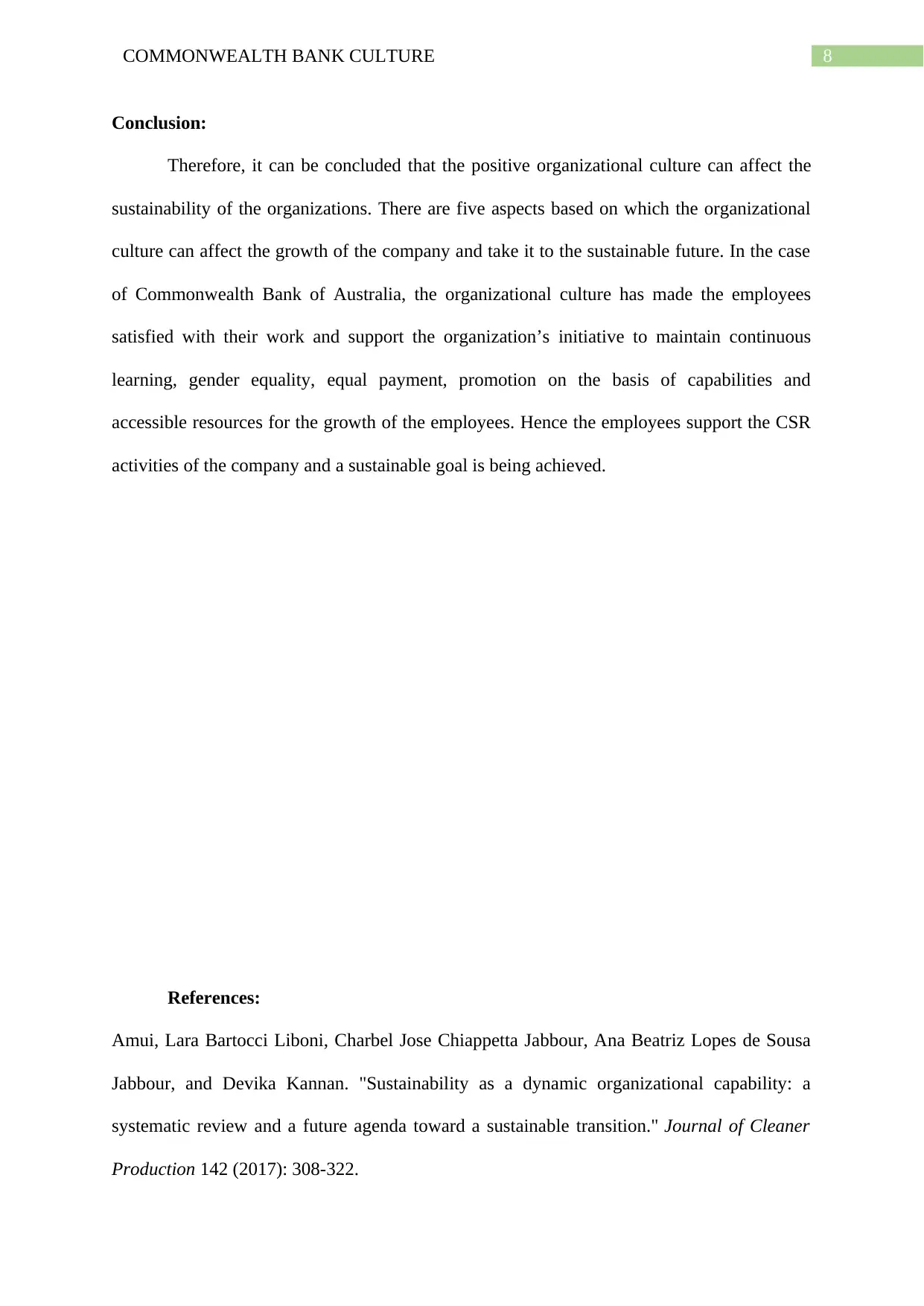
8COMMONWEALTH BANK CULTURE
Conclusion:
Therefore, it can be concluded that the positive organizational culture can affect the
sustainability of the organizations. There are five aspects based on which the organizational
culture can affect the growth of the company and take it to the sustainable future. In the case
of Commonwealth Bank of Australia, the organizational culture has made the employees
satisfied with their work and support the organization’s initiative to maintain continuous
learning, gender equality, equal payment, promotion on the basis of capabilities and
accessible resources for the growth of the employees. Hence the employees support the CSR
activities of the company and a sustainable goal is being achieved.
References:
Amui, Lara Bartocci Liboni, Charbel Jose Chiappetta Jabbour, Ana Beatriz Lopes de Sousa
Jabbour, and Devika Kannan. "Sustainability as a dynamic organizational capability: a
systematic review and a future agenda toward a sustainable transition." Journal of Cleaner
Production 142 (2017): 308-322.
Conclusion:
Therefore, it can be concluded that the positive organizational culture can affect the
sustainability of the organizations. There are five aspects based on which the organizational
culture can affect the growth of the company and take it to the sustainable future. In the case
of Commonwealth Bank of Australia, the organizational culture has made the employees
satisfied with their work and support the organization’s initiative to maintain continuous
learning, gender equality, equal payment, promotion on the basis of capabilities and
accessible resources for the growth of the employees. Hence the employees support the CSR
activities of the company and a sustainable goal is being achieved.
References:
Amui, Lara Bartocci Liboni, Charbel Jose Chiappetta Jabbour, Ana Beatriz Lopes de Sousa
Jabbour, and Devika Kannan. "Sustainability as a dynamic organizational capability: a
systematic review and a future agenda toward a sustainable transition." Journal of Cleaner
Production 142 (2017): 308-322.
⊘ This is a preview!⊘
Do you want full access?
Subscribe today to unlock all pages.

Trusted by 1+ million students worldwide
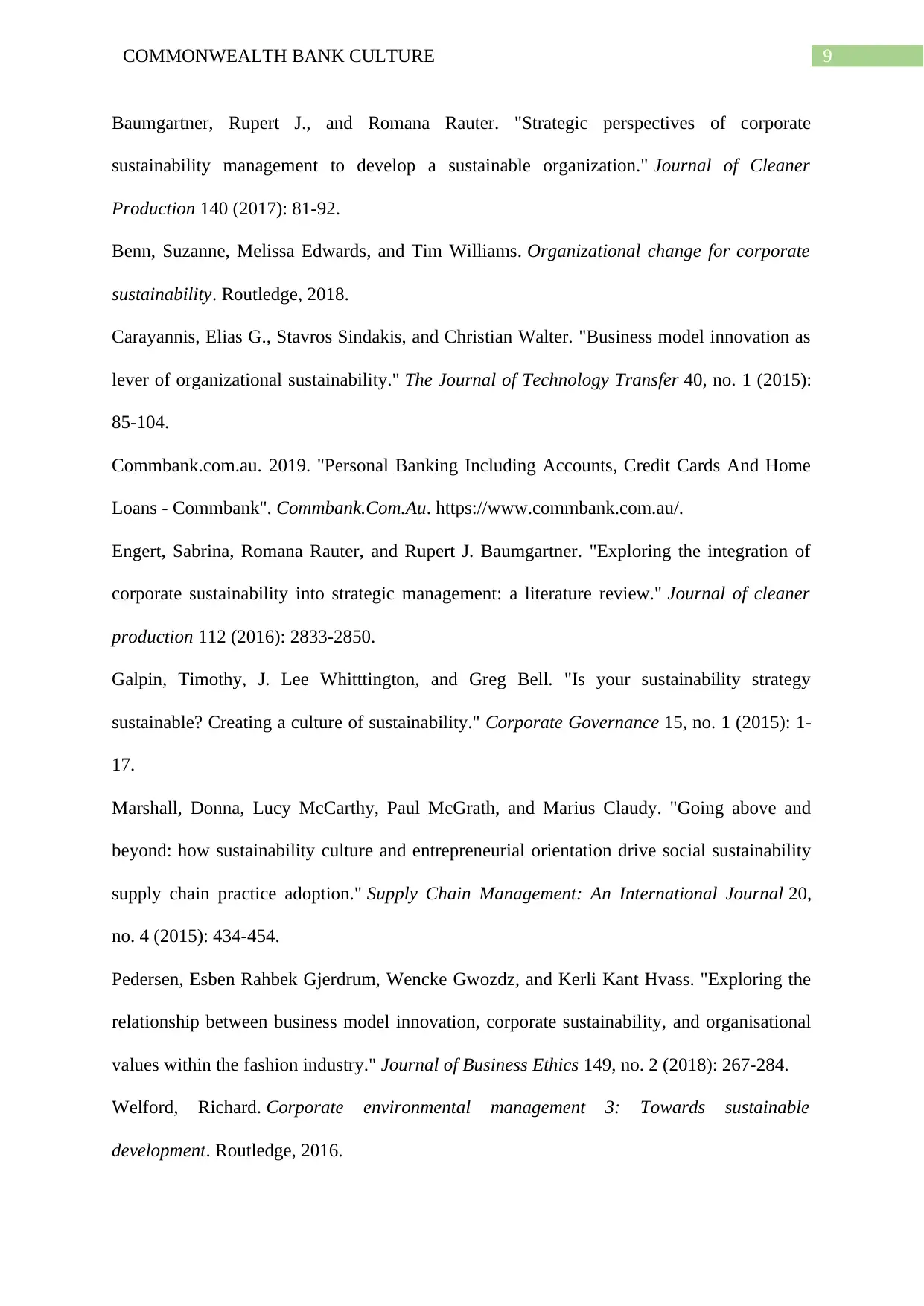
9COMMONWEALTH BANK CULTURE
Baumgartner, Rupert J., and Romana Rauter. "Strategic perspectives of corporate
sustainability management to develop a sustainable organization." Journal of Cleaner
Production 140 (2017): 81-92.
Benn, Suzanne, Melissa Edwards, and Tim Williams. Organizational change for corporate
sustainability. Routledge, 2018.
Carayannis, Elias G., Stavros Sindakis, and Christian Walter. "Business model innovation as
lever of organizational sustainability." The Journal of Technology Transfer 40, no. 1 (2015):
85-104.
Commbank.com.au. 2019. "Personal Banking Including Accounts, Credit Cards And Home
Loans - Commbank". Commbank.Com.Au. https://www.commbank.com.au/.
Engert, Sabrina, Romana Rauter, and Rupert J. Baumgartner. "Exploring the integration of
corporate sustainability into strategic management: a literature review." Journal of cleaner
production 112 (2016): 2833-2850.
Galpin, Timothy, J. Lee Whitttington, and Greg Bell. "Is your sustainability strategy
sustainable? Creating a culture of sustainability." Corporate Governance 15, no. 1 (2015): 1-
17.
Marshall, Donna, Lucy McCarthy, Paul McGrath, and Marius Claudy. "Going above and
beyond: how sustainability culture and entrepreneurial orientation drive social sustainability
supply chain practice adoption." Supply Chain Management: An International Journal 20,
no. 4 (2015): 434-454.
Pedersen, Esben Rahbek Gjerdrum, Wencke Gwozdz, and Kerli Kant Hvass. "Exploring the
relationship between business model innovation, corporate sustainability, and organisational
values within the fashion industry." Journal of Business Ethics 149, no. 2 (2018): 267-284.
Welford, Richard. Corporate environmental management 3: Towards sustainable
development. Routledge, 2016.
Baumgartner, Rupert J., and Romana Rauter. "Strategic perspectives of corporate
sustainability management to develop a sustainable organization." Journal of Cleaner
Production 140 (2017): 81-92.
Benn, Suzanne, Melissa Edwards, and Tim Williams. Organizational change for corporate
sustainability. Routledge, 2018.
Carayannis, Elias G., Stavros Sindakis, and Christian Walter. "Business model innovation as
lever of organizational sustainability." The Journal of Technology Transfer 40, no. 1 (2015):
85-104.
Commbank.com.au. 2019. "Personal Banking Including Accounts, Credit Cards And Home
Loans - Commbank". Commbank.Com.Au. https://www.commbank.com.au/.
Engert, Sabrina, Romana Rauter, and Rupert J. Baumgartner. "Exploring the integration of
corporate sustainability into strategic management: a literature review." Journal of cleaner
production 112 (2016): 2833-2850.
Galpin, Timothy, J. Lee Whitttington, and Greg Bell. "Is your sustainability strategy
sustainable? Creating a culture of sustainability." Corporate Governance 15, no. 1 (2015): 1-
17.
Marshall, Donna, Lucy McCarthy, Paul McGrath, and Marius Claudy. "Going above and
beyond: how sustainability culture and entrepreneurial orientation drive social sustainability
supply chain practice adoption." Supply Chain Management: An International Journal 20,
no. 4 (2015): 434-454.
Pedersen, Esben Rahbek Gjerdrum, Wencke Gwozdz, and Kerli Kant Hvass. "Exploring the
relationship between business model innovation, corporate sustainability, and organisational
values within the fashion industry." Journal of Business Ethics 149, no. 2 (2018): 267-284.
Welford, Richard. Corporate environmental management 3: Towards sustainable
development. Routledge, 2016.
1 out of 10
Related Documents
Your All-in-One AI-Powered Toolkit for Academic Success.
+13062052269
info@desklib.com
Available 24*7 on WhatsApp / Email
![[object Object]](/_next/static/media/star-bottom.7253800d.svg)
Unlock your academic potential
Copyright © 2020–2025 A2Z Services. All Rights Reserved. Developed and managed by ZUCOL.





